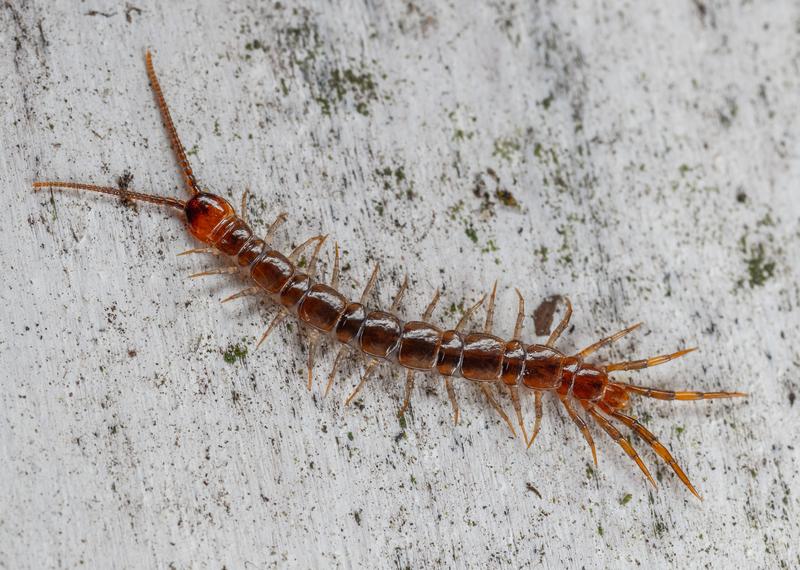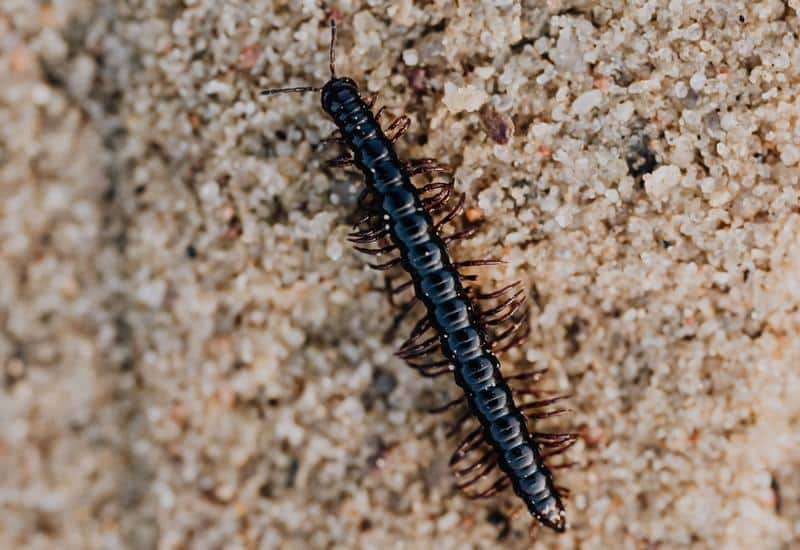Centipede Bites on Dogs: Symptoms, Can It Kill, + How to Treat!
Centipede bites on dogs: what are the symptoms and just how concerned do you need to be? Can a centipede kill a dog? In this article, we’ll answer those right away along with how to treat a centipede bite on a dog and how to prevent it happening again so you can be sure your pup stays healthy and happy.
We’ll also cover other important information you should now, like are centipedes poisonous to dogs, what to do if your dog ate a centipede, and how all of this might be different with the house centipede species. Finally, we’ll cover more on prevention by teaching you how to get rid of centipedes in the house. Keep reading!
Centipede Bites on Dogs

Centipede bites on dogs can cause a range of symptoms, from mild discomfort to more severe reactions, depending on the size of the centipede and the individual dog’s health status. It’s important that you recognize the symptoms and understand how to provide proper care if your dog gets bitten by a centipede.
Centipede Bite Dog Symptoms
Symptoms of a centipede bite on a dog can vary. Mild reactions might include localized redness, swelling, and pain at the bite site. The dog may lick or chew at the area excessively. More severe symptoms could involve drooling, difficulty breathing, restlessness, or even vomiting, indicating that your dog is in pain or experiencing an allergic reaction.
If you observe these severe symptoms, seek veterinary attention immediately.
Can a Centipede Kill a Dog?
In most cases, a centipede bite is not lethal to dogs. However, certain factors could increase the potential severity of a bite, including the size and species of the centipede, and the dog’s size, age, and overall health. Puppies, older dogs, or dogs with compromised immune systems may have more severe reactions.
Larger, venomous centipedes could also cause more significant problems. While death is unlikely, untreated severe reactions can lead to complications, hence the importance of prompt veterinary care.
How to Treat a Centipede Bite on a Dog
If your dog is bitten by a centipede, follow these steps:
- Keep Calm: Try to calm and reassure your pet.
- Examine: Examine the bite area.
- Clean the Bite: If possible, gently clean it with warm water and mild soap.
- Avoid Certain Substances: Avoid using home remedies or topical creams without veterinary advice, as some substances could worsen the irritation.
- Contact Your Vet: While mild reactions can often be managed at home, it’s always a good idea to contact your vet after a bite. If your dog shows severe symptoms or symptoms persist, take them to the vet immediately. Treatment may include pain relief, antihistamines for allergic reactions, and antibiotics to prevent infection.
Training the “Leave It” Command
One of the best ways to protect your dog from potential threats like centipedes is to train them to obey the “leave it” command. Start by holding a treat in both hands. Show your dog one closed fist with the treat inside, and say, “leave it.”
Let them lick, sniff, and paw trying to get it, but resist until they stop. Once they do, reward them with the treat from the other hand. Repeat until your dog moves away from the first fist when you say, “leave it.” Then, gradually increase the difficulty with more enticing treats and real-world scenarios.
While centipede bites on dogs are usually not life-threatening, they can cause discomfort and potential complications. Recognizing the symptoms and knowing how to respond effectively can help ensure your dog’s health and safety.
But you should also remember that while these steps will get your dog to stay away from centipedes, the underlying behavioral issues (prey drive, curiosity, overexcitement, etc.) that were causing all of this to begin with will still be present. And until you address those, any positive changes you see are only going to be temporary.
“Well, how do I make these changes last?”
By getting your dog to truly choose to follow your direction, that’s how. I tried many times to write out how you can do that before deciding it made more sense to just link you to the free video series that explains it better than I’d ever be able to.
The series is by a man named Dan who is one of the world’s leading dog obedience trainers. In it, he teaches you how to put an end to things like when your dog can’t stay away from centipedes and all other misbehavior using his fast and easy-to-follow methods.
In the first video, Dan will reveal to you why the two most common methods of dog training only doom you to failure. You can watch the video now by clicking here. Follow the proven system he’ll show you in his series and you’ll never have to spend another second worrying about centipedes biting your dog ever again!
Are Centipedes Poisonous to Dogs?

Centipedes are not poisonous to dogs, but they can bite and inject venom, which can cause discomfort and, in rare cases, an allergic reaction. It’s important to know the potential risks and how to respond if your dog encounters a centipede.
Are Centipedes Dangerous to Dogs?
While not inherently poisonous, centipedes are venomous creatures, meaning they can bite and inject venom. This venom isn’t typically dangerous to dogs but can cause localized pain, swelling, and in rare instances, an allergic reaction.
The extent of a dog’s reaction to a centipede bite can vary based on factors like the dog’s size, overall health, and the centipede’s size and species. If your dog is bitten and shows severe or worsening symptoms, it’s critical to seek veterinary care right away.
Do Centipedes Bite Dogs?
Centipedes do have the ability to bite dogs. They are generally non-aggressive and prefer to avoid confrontation. However, if they feel threatened or are handled roughly, they may bite in self-defense.
Centipedes have a pair of pincer-like appendages, called forcipules, that they use to inject venom into their prey. Dogs exploring their environment with their noses and mouths are at risk of receiving a bite.
Preventing Centipede Bites
Prevention is the best way to protect your dog from centipede bites. Keep your home and yard clear of centipedes by maintaining a clean environment, sealing cracks and gaps in your home’s foundation, and controlling other pests that centipedes feed on.
Regularly checking your dog’s outdoor play areas for centipedes can also help keep them safe. Training your dog to follow the “leave it” command can prevent them from poking their noses into places where centipedes might be hiding. We explain how to do it in the first section.
While centipedes are not poisonous to dogs, their bites can cause discomfort and, in rare cases, an allergic reaction. It’s important to keep your pet’s environment clear of centipedes and equip your dog with the training needed to avoid potential threats. If your dog does get bitten, monitor their symptoms closely and seek veterinary care if needed.
You’ll want to get this taken care of now so that you also won’t have to worry about your dog encountering any other types of insects. Questions like are cicadas poisonous to dogs, are millipedes poisonous to dogs, can dogs eat crickets, what do you do if a scorpion stings your dog, are moths poisonous to dogs, and even are stink bugs poisonous to dogs will all be no worry at all to you.
Are House Centipedes Dangerous to Dogs?
House centipedes are not considered dangerous to dogs. While they can bite and inject venom, their venom is not typically harmful to dogs, and bites are infrequent. However, it’s essential to understand how these critters interact with dogs and what to do in case of a bite.
Are House Centipedes Poisonous to Dogs?
House centipedes are not poisonous to dogs, like their outdoor counterparts. They are venomous creatures, meaning they can bite and inject venom into their prey. However, this venom is generally not harmful to dogs and poses more of a nuisance than a real threat.
The bite of a house centipede can cause localized pain and swelling in dogs, but severe reactions are uncommon. That said, individual dogs might react differently based on their overall health, size, and sensitivity. Learn the command that will help prevent future encounters in the first section.
As with any insect or arthropod bite, it’s important that you monitor your pet closely for any signs of an allergic reaction, such as difficulty breathing or excessive swelling, which would necessitate immediate veterinary care.
House Centipedes and Dogs: Risk of Encounters
House centipedes are elusive creatures, preferring to hide in damp, secluded areas of the home, such as basements or bathrooms. They are nocturnal, meaning they are most active at night when your dog is likely sleeping. This reduces the chances of encounters between your dog and a house centipede.
However, curious dogs can come across these critters during their explorations. While house centipedes are more likely to flee than fight, they may bite in self-defense if they feel threatened or cornered.
Preventing House Centipede Encounters
The best way to keep your dog safe from house centipedes is by preventing encounters in the first place. This can be achieved by maintaining a dry and clean home, as house centipedes are attracted to damp environments. Regularly cleaning and vacuuming your home can help eliminate potential hiding spots.
Training your dog to obey commands like “leave it” can also be helpful. This command instructs your dog to move away from something, which can be useful if they stumble upon a house centipede. We explain how to do it in the first section.
House centipedes are not dangerous to dogs typically. However, their bites can cause some discomfort. By maintaining a clean living environment and training your dog to avoid potential threats, you can keep your furry friend safe from any potential centipede encounters.
My Dog Ate a Centipede

If your dog ate a centipede, there’s no immediate cause for alarm. Most centipedes, including house centipedes, are not poisonous to dogs, and the risks associated with ingestion are generally low. However, it’s always a good idea to observe your dog for any signs of distress or unusual behavior and consult with a vet if concerns arise.
Dog Ate House Centipede
House centipedes are not harmful to dogs typically. While they are venomous, meaning they have the ability to bite and inject venom, their venom is not typically toxic if ingested by dogs. That being said, just like with any foreign substance, individual dogs may react differently.
If your dog ate a house centipede, monitor them for any signs of gastrointestinal upset. This could include symptoms such as vomiting, diarrhea, loss of appetite, or excessive salivation. Although unlikely, it is also possible for a dog to experience an allergic reaction, so look out for difficulty breathing, hives, or severe swelling.
If any of these symptoms appear, contact your vet immediately.
Dog Ate Centipede: Other Types
Although the house centipede is the most common type encountered by dogs, there are many different species of centipedes. Some larger, tropical varieties can pack a more potent venom. If you’re aware your dog has eaten a different type of centipede and you’re unsure of its potential toxicity, it’s best to consult with a veterinarian just to be safe.
Dog Eating Centipedes: Prevention
To prevent future incidents of your dog eating centipedes, consider implementing some environmental management strategies. These could include pest control measures to reduce the number of centipedes in and around your home.
Training can also play a significant role in prevention. Commands such as “leave it” are incredibly effective when your dog picks up something they shouldn’t, including centipedes. Regular training helps reinforce this command, making your dog more likely to respond to it in the moment. Learn how to do it in the first section.
In conclusion, while it can be alarming when your dog eats a centipede, it’s usually not something to panic over. Keep an eye on your dog for any adverse reactions and reach out to a vet with any concerns. With appropriate home management and training, you can reduce the likelihood of this happening again in the future.
How to Get Rid of Centipedes in House
To get rid of centipedes in your house, it’s important that you focus on reducing their habitat and food sources. This involves keeping your home dry, sealing cracks and gaps, removing clutter, and treating the area with pesticides if needed.
Here are detailed steps for effective centipede control:
- Keep Your Home Dry: Centipedes thrive in damp environments. To deter them, fix any leaks, use a dehumidifier in humid areas like basements, and make sure your home is well-ventilated.
- Seal Cracks and Gaps: Centipedes enter homes through cracks, gaps, and holes. Seal off any possible entry points, including the gaps around doors, windows, pipes, and wiring.
- Remove Clutter: Clutter provides centipedes with places to hide. By keeping your home tidy, especially in areas like basements, attics, and closets, you limit their hiding places and make your home less appealing to them.
- Regular Cleaning: Regularly clean your home, especially dark, damp areas. Centipedes feed on other pests, so keeping your home clean helps eliminate their food source.
- Use Pesticides: If the infestation is severe, consider using pesticides. Opt for ones specifically designed for homes with dogs and to kill centipedes. Always follow the manufacturer’s instructions.
Remember that the best way to handle a severe centipede infestation is to call a professional pest control service. They have the expertise to identify the source of the problem and apply treatments effectively and safely.
I’m sure you’re ready to not worry about any encounters between a centipede and your dogs any longer, so I’ll let you get to work on all of this. Best wishes, and thanks for reading our article “Centipede Bites on Dogs: Symptoms, Can It Kill, + How to Treat!”





